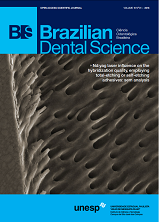Nd:YAG laser influence on the hybridization quality, employing total-etching or self-etching adhesives: sem analysis
DOI:
https://doi.org/10.14295/bds.2016.v19i1.1174Resumo
Background: The application of Nd:YAG laser on dentin with the adhesive system non-polymerized can influenced the quality of hybrid layer formed. Objectives: The aim of this study is to assess through analysis by scanning electronic microscopy (SEM), the Nd:YAG laser influence on the hybridization quality, using conventional Adper Single Bond (SB) or self-etching Clearfil SE Bond-Kuraray (CSEB) adhesives. Methods: Nine bovine incisors were treated on their incisal with SB and with CSEB in their cervical portion. They were divided into 3 groups with 6 specimens in each and treated as follows; G1- adhesive system and polymerization; G2- adhesive system, laser (60mJ/pulse) and polymerization; G3- adhesive system, laser (140mJ/pulse) and polymerization. All samples were restored with composite resin (Filtek Z350-3M). The thickness, the presence of failures (gap/porosity) and tags/microtags in the hybrid layer were analyzed using the SEM. The data were submitted to ANOVA and Tukey statistical tests 5%. Results: The highest average of hybrid layer thickness (1.89±0.15) was observed for G3 and the smallest was observed for G1-CSEB (1.36±0.14). The multiple comparison of ratio test showed that the smallest prevalence of failures was for G3-CSEB and the best performance for the presence of tags/microtags was found for G2-SB. Conclusion: Independent of the adhesive system used, the Nd:YAG laser, according to the parameter applied, had a positive influence on the hybridization quality.
Downloads
Downloads
Publicado
Como Citar
Edição
Seção
Licença
TRANSFERÊNCIA DE DIREITOS AUTORAIS E DECLARAÇÃO DE RESPONSABILIDADE
Toda a propriedade de direitos autorais do artigo "____________________________________________________________________" é transferido do autor(es) para a CIÊNCIA ODONTOLÓGICA BRASILEIRA, no caso do trabalho ser publicado. O artigo não foi publicado em outro lugar e não foi submetido simultaneamente para publicação em outra revista.
Vimos por meio deste, atestar que trabalho é original e não apresenta dados manipulados, fraude ou plágio. Fizemos contribuição científica significativa para o estudo e estamos cientes dos dados apresentados e de acordo com a versão final do artigo. Assumimos total responsabilidade pelos aspectos éticos do estudo.
Este texto deve ser impresso e assinado por todos os autores. A versão digitalizada deverá ser apresentada como arquivo suplementar durante o processo de submissão.




























